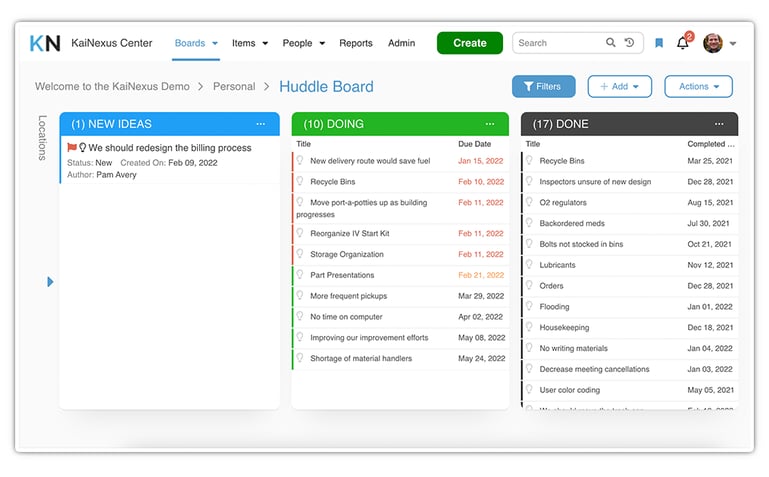 When I decided to write this post, I thought it would be interesting to see what others have written about the practice of daily huddle meetings. Wow! There are a lot of ideas out there about what should happen during a huddle. It took me a minute to realize that not every organization gears its huddle toward continuous improvement. Some use the huddles for team building, status updates, training, or even employee performance evaluation.
When I decided to write this post, I thought it would be interesting to see what others have written about the practice of daily huddle meetings. Wow! There are a lot of ideas out there about what should happen during a huddle. It took me a minute to realize that not every organization gears its huddle toward continuous improvement. Some use the huddles for team building, status updates, training, or even employee performance evaluation.
That’s all fine, of course, folks can use their huddle for whatever they like, but if your goal is to use your daily huddle as part of a continuous improvement initiative, there are some warning signs that all is not well. In the context of improvement, the goal of the daily huddle is to agree on the priorities for the day. That seems simple enough, but it’s not as easy as it sounds. Here are a few of the problems that can come up and how to tackle them.
The conversation is about the past
Huddle meetings are held daily because they are focused on what is going to happen over the course of the day. Of course, this discussion requires that folks are up to speed on what has happened in the past, but if you spend your meeting talking about yesterday, today’s priorities don’t take shape. A smart approach is to adopt a digital huddle board that allows team members to make real-time updates as they complete improvement work. That way, everyone can check out the board before the meeting, shift away from status updates, and keep the discussion about yesterday to pressing questions.

The conversation is about the distant future
It seems that sometimes people forget that the daily huddle meeting isn’t the only meeting. It is entirely appropriate to hold meetings to discuss long-term plans or address complex issues, but that is outside the scope of the daily huddle which is about what will happen in the very near term. A good rule of thumb is that if it didn’t happen after the last huddle meeting or won’t happen by the next, the daily huddle probably isn’t the best place to discuss it.
Only a few people speak up
Everyone on the team should be contributing to positive change, so everyone should have something to say about the improvement priorities of the day. It isn’t always easy for people to speak up, so it is the responsibility of the person running the meeting to make sure everyone is heard. Many teams have people take turns running the meeting, which is a helpful way to get more people involved and give everyone a chance to stretch their leadership muscle.
There is disagreement about priorities
Daily huddles are the execution arm of strategy deployment. (Huddles don’t make the strategy; they make the strategy happen.) If there is disagreement about daily priorities, it is likely that your strategy deployment efforts have not hit the mark. When everyone understands the most pressing initiatives of the organization and goals are cascaded from the top-level to the individual, agreeing on priorities is a piece of cake. If it’s a challenge, leaders should revisit how the strategic plan has been communicated.
People are frequently absent
If people often miss the huddle because they are in another meeting or working on something else, that’s a clear sign that the daily huddle isn’t providing value. Team leaders can legislate people into attendance, but if the meetings are useful enough, that isn’t necessary. If you have team members who can’t physically attend the meeting because they are working from another location or remotely, strongly consider an electronic huddle board so that they can participate from wherever they are.
The huddle drags on forever
The daily huddle should last no more than 15 minutes. If it goes beyond that, most of the conversation is likely to be out of scope. If there is a problem or opportunity that requires more discussion, another meeting should be scheduled to execute a continuous improvement cycle like PDSA or DMAIC. This is important because allowing the meeting to drag on will make it less valuable for employees, it will move the focus from today, and it will lead to people jumping to solutions without fully understanding the root cause of problems. Keeping the time tight will help keep the meeting focused.
Of course you can always take away the chairs, but you knew that already.
If your daily improvement huddle meetings suffer from any of these problems, don’t feel bad. It’s pretty common. Just regroup, remind everyone about the limited purpose of a CI daily huddle, and give it another go.



Add a Comment